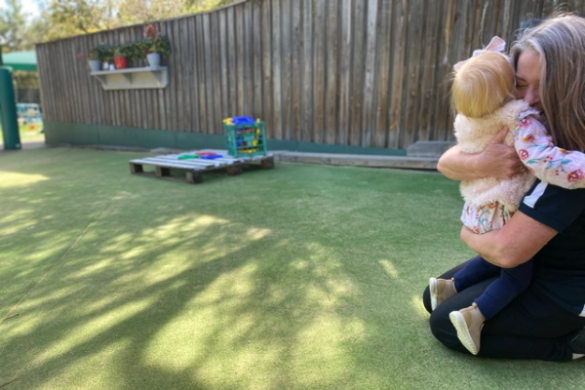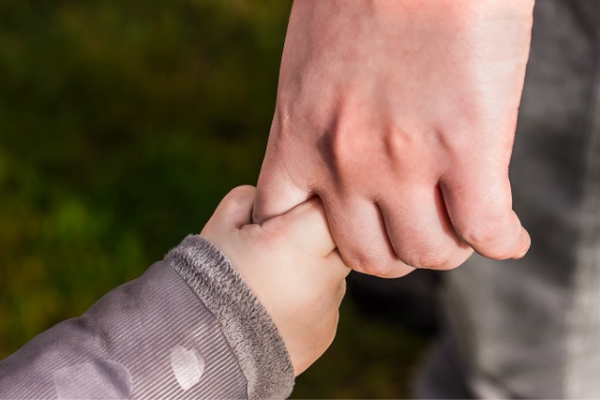Separation anxiety is one of the biggest concerns for parents who are placing their children into care for the first time. We reached out to Sutherland Shire Council’s early childhood experts, to get some insight into this very normal part of children’s development.
At what age is separation anxiety likely to occur? How can you minimise its likelihood and support your child?
Learn why separation anxiety occurs and use these practical tips to support your child (and you!) during this important transition.
Read on if your child is starting childcare in 2022, or returning to care following an extended period at home during lockdown.
Separation anxiety is a natural development
Separation anxiety is part of a child’s natural and normal development. Regardless, it’s very difficult for parents to experience. No one ever wants to see their child upset.
It can occur when a parent physically separates from their child, such as leaving them in the care of others. In childcare settings, it can occur when a child first starts care or during different stages of the child’s development.
Separation anxiety can start from age eight months and peaks at around 14-18 months old.
Varying degrees of separation anxiety
Separation anxiety can occur in varying degrees, from mild to chronic:
- A child may be distressed at drop-off, however with cuddles, reassurance and distraction they naturally assimilate into the centre’s routine. Most children who experience separation anxiety fall into this category.
- A child may also become upset on and off during the course of the day, however, the child’s Educators are able to resettle them, again with support and reassurance.
- A child is chronically upset and there are no glimpses of a decrease in their distress. These occurrences tend to be less common.
Children who experience separation anxiety may suddenly cry when they see their parent at pick up time. This is totally normal. Even when the child has had a great day, they remember why they were upset in the morning and these feelings of separation anxiety resurface in a flood of emotions when they see you.

Preparing your child for childcare
The good news is, there are very specific things both parents and childcare providers can do to support every child starting care.
Within Sutherland Shire Council’s Early Education Centres and Family Day Care services, our Educators work in close partnership with families to foster every child’s transition into care, with the goal of making it as smooth as possible.
We meet with families to learn about their child’s likes and dislikes. During play visits, we set up activities of interest to the child, to help them engage with their new environment and feel a sense of belonging.
We liaise closely with families of children who are experiencing separation anxiety, to jointly develop strategies to support their child’s specific needs.
It’s also important to us that we remain in close contact with families during the day to let them know how their child is going.
We also encourage parents to call us as often as they need. We want parents to feel reassured about their child’s progress. We will always be honest if we feel their child needs further support.
Tips for parents sending children to childcare
- Arrange a series of visits to the service to allow your child to become familiar with their new environment. Give them time to get to know their Educators, some of their peers and the environment, along with engaging in the routine (e.g. placing bag in locker, washing hands upon arrival, walking into room to say hello).
- Talk positively about ‘kindy’ (or the name you will refer to the service as at home) and activities your child may do there. Children will very quickly pick up on their parent’s distress or negative feelings.
- Let your child bring one of their favourite items with them from home, such as a soft toy or blanket, to help them feel safe and secure. You may also like to send in a family photo, so your child can see their family whenever they need to during the day.
- Decide on a drop-off routine and let your child know in advance what to expect and what will happen when they arrive at kindy. This will help your child feel secure when they arrive. Here is an example: “When we get to Kindy, we’ll put on your sunscreen and then we’ll put your bag in your locker. We will say hello to your teachers and after that, I will leave and you will stay at Kindy with your teachers. I will come back to pick you up after afternoon tea.”
- Follow through with your plan – it’s important to be consistent with your routine when dropping your child off.
- If you prefer, you may decide to drop-off quickly and give your child a hug and kiss and hand your child to one of our Educators who will take the time to calm and soothe your child before assisting them to transition into play.
- It is always better to hand your child to us (even through their tears). Handing your child to us – rather than us ‘taking’ your child from you – tells the child that you trust us and it is okay to come to us while still missing you. We appreciate this can be difficult for you as well as your child.
- Stay calm and try to look happy and relaxed. When a child is crying, many times as parents, we apologise for leaving. This unintentionally tells your child you’re not comfortable with them staying at kindy. Rather than saying, “I’m sorry, Mummy has to leave now” try “It’s time for Daddy to leave now. Have a fun day! I will see you after afternoon tea.”
- Say goodbye and leave – these are the most important two steps to a successful drop-off.
-
-
- Say goodbye: it may seem best to quietly leave when your child is busy playing and skip the goodbyes. Your child is happy, focused and confident you are nearby. When he or she realises you are gone, panic may set in. In your child’s mind, you didn’t leave but rather disappeared, which may cause them to become anxious.
- Time to leave: it’s best not to prolong the goodbye. If you’re not leaving immediately, do not say goodbye. Once you’ve said goodbye, the best outcome is to leave promptly and with a smile.
-
- Read stories – there are many books available that can help you and your child talk about their new environment. The following are available via Sutherland Shire Libraries:
-
-
- The Kissing Hand (Audrey Penn)
- Maisy goes to playschool (Lucy Cousins)
- First day at playschool (Vivianne French)
- Lenny goes to nursery school (Ken Wilson-Max)
-
Experience tells us that with lots of gentle encouragement, cuddles, praise and practice, children will gradually settle into their new environment. Our goal is for every child to thrive, be happy and feel a sense of belonging within our community of learning.
Sutherland Shire Council operates 11 Early Education Centres and 17 Family Day Care services. Learn about their services and apply for care online at www.sutherlandshire.nsw.gov.au/childcare
